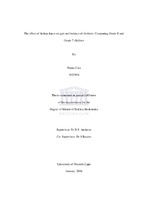| dc.description.abstract | Through the process of motor learning and control, new skills are then developed. There are various physical activities that enable the development of new motor skills, one being dance. Numerous studies have found that dance has improved sensorimotor control of body sway following just a single dance session. Furthermore, learning dance engages a variety of cognitive resources that improve postural control of children. Dancing therefore contributes to the development and refinement of the fundamental motor skills like gait and balance. The aim of this research was to determine the effect of dance training on gait and balance of Grade R and Grade 7 school children, and to investigate which age group would best demonstrate these effects. This study was conducted using an intervention and control group. The Grade R intervention group constituted a sample of thirty-four participants, the Grade R control consisted of twenty-seven participants, the Grade 7 intervention group and control group consisted of twenty-one participants each. Three different testing instruments were used; a 10-meter walk test for stride pattern analysis, a dynamic balance test known as the tandem gait and the static balance test known as the tandem stance balance test. Both the control and experimental group were required to perform these tests before and after the intervention period. The dance training lasted a period of six weeks and was conducted on a weekly basis. Following the intervention it was found that only Grade R stride pattern in terms of stride frequency was significantly changed and that no significant changes were seen at any time for Grade 7 children stride pattern and balance. The balance changes were seen for both Grade R intervention and control groups, showing that the children were improving with physical activity, which cannot be attributed to dance alone. This highlights that training should be started at the young age, and that physical activity programs like dance are good and diverse options to consider when designing such activities. | en_US |

